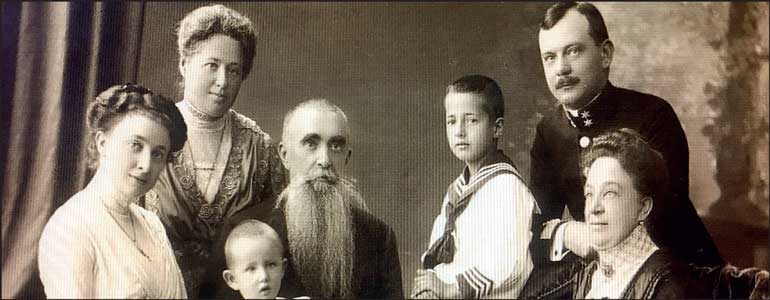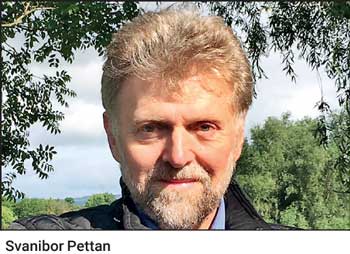Monday Dec 08, 2025
Monday Dec 08, 2025
Saturday, 20 April 2024 00:10 - - {{hitsCtrl.values.hits}}

 The Harmony page is dedicated to continuing providing local and international expertise to the Lankan readership in the fields of arts, culture and communication and today we feature an interview with Svanibor Pettan, professor and chair in ethnomusicology at the University of Ljubljana, Slovenia.
The Harmony page is dedicated to continuing providing local and international expertise to the Lankan readership in the fields of arts, culture and communication and today we feature an interview with Svanibor Pettan, professor and chair in ethnomusicology at the University of Ljubljana, Slovenia.
Working extensively on music of minority communities in the world he holds academic degrees from universities in Croatia, Slovenia, and the United States. Among his fieldwork sites are former Yugoslav lands, Unites States, Australia, Egypt, Norway, Sri Lanka and Tanzania.
The themes in his academic publications include multiculturalism, gender, and applied ethnomusicology.
Prof. Pettan has served as visiting professor in universities across Asia, Europe and North America, delivering around 100 invited lectures worldwide.
He is past Secretary General and current head of the International Council for Traditional Music and the founder of its Study group on applied ethnomusicology and Chairperson of its Study group on music and minorities.
Below is the interview with Prof. Svanibor Pettan.
By Surya Vishwa
Q: Tell us about your childhood, where you grew up and the early influences that directed you on the path to music.
A: My roots are quite colourful with references to central Europe. My ancestors are Slovenian, Croatian, Austrian, Italian, and Polish.
Just take a look at the accompanied photograph from about 110 years ago, featuring my father as the youngest member in a single family featuring three ethnicities – Slovenes, Croats, and Austrians.
My father became a composer, musicologist, and music pedagogue, while my mother was a music teacher. Music making in a family evokes nice memories. Especially during Christmas time. My grandma, who lived with us, played piano, father violin, mother recorder, and I played cello.
Q: Could Slovenia be described as having a very ‘musical culture.’ Please run us through your beautiful country and its musical heritage.
A: There is a lot of diverse music in Slovenia. Located between the Alpine mountains, Adriatic Sea, and Pannonian flatlands, it demonstrates a variety of influences and the resulting expressions in traditional folk music. As a part of the Habsburg Empire for centuries, it actively shares the centuries-long history of central European art music culture, which continues to be amplified by close proximity to Austria and Italy. A multitude of popular music genres, such as pop, rock, heavy metal, and rap, are at home in Slovenia, but the most widespread is the hybrid genre known as narodnozabavna glasba, which literally means folk-pop music and enjoys Pan-Alpine popularity. Also, Slovenes love multipart singing, so choirs are cherished by all generations.
Q: How did studying music formally help you in perfecting your innate talent as a musician and what are the core elements of the music degrees offered in Slovenia and your university?
A: I grew up in Zagreb, political capital of modern Croatia and the former cultural capital of what was Yugoslavia. It was considered normal for a child with musical life intentions to attend parallelly a general (first elementary and then secondary) school and a music school. Music school gave me knowledge and skills in playing a selected instrument (in my case it was cello, later also French horn, with piano as a side obligatory instrument), in music history and various aspects of music theory. I was fortunate to be in a position to upgrade these during my bachelor’s study of musicology in Croatia, master’s study in Slovenia, and doctoral study in the United States of America, with an ever-stronger focus on ethnomusicology. I gradually moved from Western art music to popular and traditional music, from music at home to music of the world, or in other words to studying “music wherever whenever”.
Q: There is sometimes the view (as was expressed by artists such as Van Gogh) that universities in attempting to theoretically fine tune art may halter it – this is a rather radical view, but we do see for example musicians who are entirely self-taught for example Jackie Evanko and Susan Boyle who seemed to perform their strongest without any ‘formal training.’ Your comments?
A: Let me share with you my own experience. As an undergraduate student back in the 1980s, I took a chance to do ethnomusicological fieldwork in a village on the Croatian-Slovenian border. Meeting a self-taught violinist in his eighties with unfinished elementary school turned out to have a lasting impact on my life. His wisdom and attitudes were so different from what I experienced by then that I decided to become an ethnomusicologist.
Imagine, my father was an urban intellectual to whom some colleagues referred to as a “walking encyclopaedia” and for whom and his work I had and still have utmost respect, but I allowed myself to get immersed into research on music that was almost unknown to me. There are very different music systems and ways of learning music in our world, and I keep my eyes widely open all these decades, wishing to learn and understand as much as I can both theoretical and practical aspects of the phenomenon, which we call music.
Q: Sri Lankan musician and ethnomusicologist Lasanthi Manaranjani is your wife, having done her doctorate in your university. Through her you must be exposed strongly to Lankan music traditions and histories. What role do you think the music heritage of this island and its majority and minority communities can play in helping Sri Lanka to develop its own sustainable and creative peacebuilding model?
A: I am glad that you brought together music and peace in your question. For me, music is not just an art. It is also a tool that can be used for achieving very different aims. Music is historically used to boost the morale of soldiers going into battle, to provoke and scare those seen as enemies, to call for involvement of those who are not directly affected by the conflict, to support peace efforts, to heal the war wounds, to help in reconciliation and so on. In a multiethnic, multireligious, and multicultural countries, such as Sri Lanka, it has strong potential in the realms all the way from education to tourist promotion.
The current situation in the world reminds us again and again that peace is not a given, it is an ideal for which we have to use all our efforts to achieve and maintain it. Way before any war appears on a horizon.
Lasanthi and I keep working together, learning from each other in researching war – peace continuums. Our publications point to certain commonalities, but also differences in musical reflections of war and peace in the two geographically distant territories.
In Slovenia, she formed an ensemble together with fine Slovenian musicians interested in performing various Sri Lankan music. In addition to concerts in the country and abroad, this ensemble also recorded a CD. Lasanthi earned much praise over there by also performing Indian classical music on violin and by learning and singing Slovenian and other Slavic songs, demonstrating respect to several cultures.
Q: You are a global champion in using music for elevating humanity and its understanding of the unified connections of co-existence. How did you come to become a sounding voice of ICTMD in this process?
A: ICTMD, the world’s leading international association of ethnomusicologists, caught my attention in the student years, when I realised how it was successfully crossing political boundaries under the harsh conditions of the Cold War, enabling music and dance scholars to meet and share their findings regardless of their countries of residence. Its first world conference took place back in 1948 in Switzerland, a neutral country, the later ones were moving to countries within NATO and Warsaw alliance as well as to Yugoslavia, a non-aligned country. Scholars were generally trying to be “objective” and distanced from the objects of their work. In 2005, I served as program chair of the world conference in the United Kingdom and introduced the themes such as music and war and engaged scholarship, which received attention and support from the participants.
In 2007, encouraged by the well-received double panel with global participation in Vienna, I initiated the establishment of the Study Group on Applied Ethnomusicology within the ICTMD, pointing to the need of using our knowledge, understanding and skills for the betterment of the circumstances of individuals and communities we study. Now we don’t rely only on methods such as participant observation, but also point to participatory action research and other collaborative efforts with the elements of activism for the common good. My extensive service as Secretary General, Vice-president, and currently as President reflects these developments in ICTMD.
Q: Today this organisation is a global and UNESCO linked entity bringing together musicians and music related scholars around the world to help support and conserve music traditions of small groups of people, i.e. the minority communities across the world. Could you throw light on the ICTMD’s plans for this year and its core contributions so far?
A: A couple of years ago, Naila Ceribašić, Don Niles, and I co-edited a monumental book about the first seven decades of ICTMD, which is freely available at the following link: https://e-knjige.ff.uni-lj.si/znanstvena-zalozba/catalog/book/344.
A formal consultative status with UNESCO is an important part of the ICTMD’s identity. World Conference in Legon, Ghana, in July 2023 testifies to our intention to reach colleagues on all continents. Namely, despite ICTMD’s unique presence in as many as 134 countries and regions of the world, we still wish to welcome several missing ones in Africa to our World Network and enable mutually beneficial communication. Sri Lanka’s ICTMD National Committee helps in integrating the country’s ethnomusicologists, ethnochoreologists, and other music and dance specialists mobilising them to participate in both national and international projects. The next World Conference will take place in New Zealand in January 2025, and I expect good Sri Lankan representation, including both onsite and online participants.
Q: The ICTMD had its last global symposium in Sri Lanka in December. Where do you think this organisation will focus on this year for its 2024 symposium?
A: Oh, I am still delighted about the symposium, which in December 2023 brought to Colombo members of two prominent ICTMD Study Groups, Music and Minorities and Indigenous Music and Dance. Sri Lankan organisers from the University of Kelaniya as well as scholars and performers from various parts of the country created an inspiring and rich learning experience. Some 60 scholars from 20 countries enjoyed it so much that the continuation will take place as soon as this year in Chiayi in Taiwan.
Q: What are your views of strengthening the scholarship based theoretical with the practice in music for influencing progressive policies where needed to use arts and culture for both economic prosperity and peacebuilding?
A: By all means. When I started using music in work with Bosnian refugees in Norway in the 1990s, there was no suitable theoretical basis for it in ethnomusicology, so practice had to precede theory. Later on, my Norwegian host Kjell Skyllstad and I created a model composed on research, education, and music-making. Norwegian music students and Bosnian refugee musicians formed an ensemble in which they were teaching each other and learning from each other, projecting in their concerts mutual support, compassion, and artistic creativity. I accompanied the concerts taking place in a range from refugee centres to national theatre with bi-lingual speeches aimed to contribute to better mutual understanding and support.
Books such as the Oxford Handbook of Applied Ethnomusicology from 2015 provide many inspiring cases in different parts of the world and in different areas of human activities, on how we as musicians can contribute to sustainability and resilience of life on our threatened home planet.